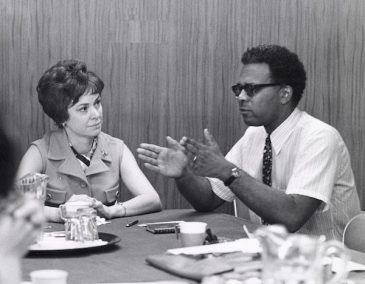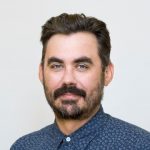In 1968, a year before Sesame Street went on the air, the fledgling Children’s Television Workshop (CTW) staff—including Joan Ganz Cooney, Robert Davidson, David Connell, Dr. Edward Palmer, Barbara Frengal, Samuel Gibbon, Anne Bower, James McConnell, and John Stone—conducted a seminar covering five key topic areas that Joan Ganz Cooney had identified in her extensive report to the Carnegie Corporation in 1966, The Potential Uses of Television in Preschool Television.

The seminars brought together leading experts in the fields of early childhood education, television, children’s book authors and illustrators, as well as noted psychologists and psychiatrists. The purpose of these seminars was to “generate ideas for the production staff to develop into 130 hours of children viewing” (Report of Seminar II, Language and Reading).
Many of the participants and advisors saw an opportunity to utilize this new experiment in television to fill some of the evident and harmful gaps in early childhood education across the country. Dr. Chester Pierce, a psychologist and professor who was a national advisor for CTW and who would become the founding president of the Black Psychiatrists of America in 1969, also saw an opportunity to provide widespread, radical therapeutic treatment for Black children.
Dr. Pierce believed television—and Sesame Street in particular—could play a strong role not just in entertaining children, but in countering the racist messaging that was so pervasive during the 1960s. Black children absorbed countless microaggressions (a condition and term that he first identified and coined) via media representation. By presenting an integrated, harmonious community to “challenge the marginalization of African-Americans that children routinely saw on television and elsewhere in society,” Pierce felt Sesame Street could offer a “vision of an integrated society where everyone was a friend and treated with respect.”
In The Smithsonian, Bryan Greene writes that Dr. Pierce helped design what he called the show’s “hidden curriculum” of helping young Black children develop a stronger sense of self-worth through positive Black role models. By presenting an integrated, harmonious community to “challenge the marginalization of African-Americans that children routinely saw on television and elsewhere in society.”

From my own personal, imperfect perspective, the appearance of Jesse Jackson reciting the poem “I Am Somebody” (episode 402 of Season 3) by Reverend William Holmes Borders, Sr., quite perfectly sums up Dr. Pierce’s “hidden curriculum” that “seeks to bolster the Black and minority child’s self-respect and to portray the multi-ethnic, multi-cultural world into which both majority and minority child are growing.”
And while the special guests throughout Sesame Street’s production—including the likes of Odetta Holmes, Mahalia Jackson, Herbie Hancock, Nina Simone, James Earl Jones, Whoopi Goldberg, The Harlem Globetrotters, and Lena Horne to name just a few—illuminate the dedication to Dr. Pierce’s vision by highlighting the diverse talents of so many remarkable men and women of color, the foundation is built on the positive representation of everyday role models consisting of both women and men of color as business owners, as mothers and fathers, as husbands and wives, as community members, as lasting friends, and as, well, the people in your neighborhood.
 Conrad Lochner is the Senior Manager of Archive and Collections at Sesame Workshop. A graduate of Pratt Institutes School of Information Science, he has specialized in building and managing archival resources in the non-profit sector and is committed to bringing to light the often-hidden collections of these organizations. His favorite Sesame Street character is Grover and would like to one day work at The Fix-It Shop.
Conrad Lochner is the Senior Manager of Archive and Collections at Sesame Workshop. A graduate of Pratt Institutes School of Information Science, he has specialized in building and managing archival resources in the non-profit sector and is committed to bringing to light the often-hidden collections of these organizations. His favorite Sesame Street character is Grover and would like to one day work at The Fix-It Shop.


